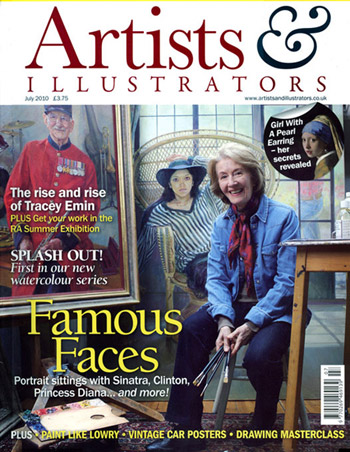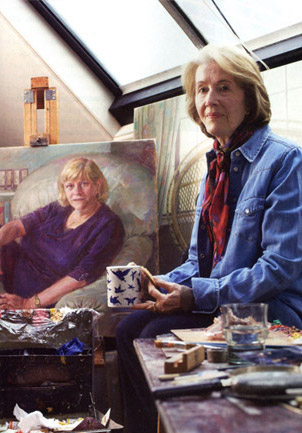Famous Faces by Steve Pill. Originally published in Artists & Illustrators Magazine, July 2010
After a childhood spent touring with her musician mother, June Mendoza settled upon art as her discipline of choice and started life classes aged 14. She was awarded an OBE in 2004 and has painted the various members of the Royal Family on multiple occasions. Other notable sitters include Lord Jeffrey Archer, Sir Terry Wogan and Baroness Margaret Thatcher.

Are you trying to say something about your sitters?
Oh golly, yes! I mean, otherwise you know there would be no point - you might as well do the same head over again if you are just using the person as an object. If you are going to show more than the head and shoulders, something that interests me is body language. It makes each person different.
Do high-profile commissions come with stricter requirements?
Sometimes they do. If it's not valid, I'll tell them so, on my terms. After all, they've come to me for the sort of work I do. If it's not valid, I'll say why and that is usually acceptable. If they have something to contribute, it is usually very interesting. They might suggest something you haven't thought of - a dress you haven't seen.
Have you ever been intimidated by anyone's presence?
I can't remember anybody. I've been tense about a job for a lot of reasons. The usual one is that you've not got perfect conditions - if you've got bad lighting or someone who answers the phone all the time, or you've got a shortage of time. You don't get excused for some of the conditions that get imposed on you. That leads to a lot of tension. Some jobs are more important publicly than others but when you are doing the job, you've got the same responsibility to achieve a good outcome with your family as you have with the Royal Family.
So did you treat Princess Diana in the same way as any other sitter, for example?
Well you've got to, haven't you? You are just doing what you are always doing. Yes, there might be extra tensions because of time limits but, if you have the time, there is no difference.
When time is tight, are there certain things you might leave out?
Yes. For instance, when I go through their wardrobe (which I did even with Princess Diana), if they pick out something with a pattern, you can say no to that. It might look great on them but I haven't got time to do that. It is selection, all the way. Every brush stroke is a selection.
What has been your most enjoyable sitter?
That's an almost impossible one. I've painted lots of lovely, lovely people. A recent one was PD James - she's a darling, I love her! She's a dear, dear lady and bright as anything. She's become a good friend.

Is it important to be sociable with your sitters?
It depends how you are working. I like to get something about that person in the painting. It's just part of what you are communicating.
You mix commissions with what you call 'pick-ups' - people you meet in everyday life. What do you look for in a potential face?
It might be anything, that's the joy of it. People are so varied. I've picked people up in pubs, ladies' luncheons, formal dinners and even in the street virtually. They are usually a bit surprised. You have to make it clear that you are not fooling around, that you are a professional. My lovely scaffolder, I picked him up from the scaffolding outside a room where I was painting four presidents of the Royal Academy of Engineering. When my subjects left, he came to the window and I said, "Will you sit?" and he said, "Yes". Lovely guy.
About a third of my work is self-generated. There came a time when I was on demand all the time but I started inserting self-generated ones and I was excited all over again. It means you are not on the sausage machine, just turning out commissioned portraits.
Do you think portrait painters have a responsibility to explain what they intend to do to their sitters?
Yes, I like them to see as the picture grows. I like them to know what they are sitting there all that time for. They then end up with an appreciation of how it happens and they are with you on it. There is always that stage about two-thirds of the way through when you frighten the hell out of them because it looks as if it is almost finished when there are still so many things wrong with it. They say, isn't the arm too fat or the nose too blue? It's a very good thing to frighten them because when it comes out right, they are so relieved that they don't worry about the other little things.
Have you ever been 100% satisfied with a portrait?
No. I've done a few where I think it's not too bad. There is always a flaw. It's a bit like going out the door on holiday and when you get to the airport, you discover you've forgotten something, whether it's something unimportant or it's your passport. Once you've discovered that flaw, you just have to live with it, as long as it's not too serious.
